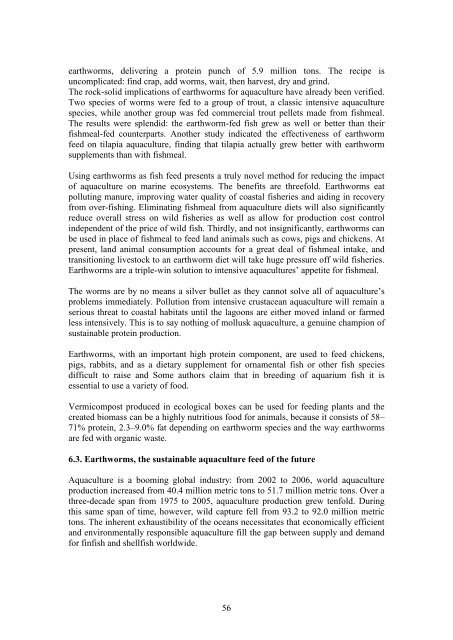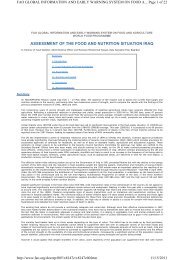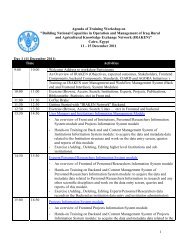Vermiculture in Egypt: - FAO - Regional Office for the Near East and
Vermiculture in Egypt: - FAO - Regional Office for the Near East and
Vermiculture in Egypt: - FAO - Regional Office for the Near East and
Create successful ePaper yourself
Turn your PDF publications into a flip-book with our unique Google optimized e-Paper software.
earthworms, deliver<strong>in</strong>g a prote<strong>in</strong> punch of 5.9 million tons. The recipe is<br />
uncomplicated: f<strong>in</strong>d crap, add worms, wait, <strong>the</strong>n harvest, dry <strong>and</strong> gr<strong>in</strong>d.<br />
The rock-solid implications of earthworms <strong>for</strong> aquaculture have already been verified.<br />
Two species of worms were fed to a group of trout, a classic <strong>in</strong>tensive aquaculture<br />
species, while ano<strong>the</strong>r group was fed commercial trout pellets made from fishmeal.<br />
The results were splendid: <strong>the</strong> earthworm-fed fish grew as well or better than <strong>the</strong>ir<br />
fishmeal-fed counterparts. Ano<strong>the</strong>r study <strong>in</strong>dicated <strong>the</strong> effectiveness of earthworm<br />
feed on tilapia aquaculture, f<strong>in</strong>d<strong>in</strong>g that tilapia actually grew better with earthworm<br />
supplements than with fishmeal.<br />
Us<strong>in</strong>g earthworms as fish feed presents a truly novel method <strong>for</strong> reduc<strong>in</strong>g <strong>the</strong> impact<br />
of aquaculture on mar<strong>in</strong>e ecosystems. The benefits are threefold. Earthworms eat<br />
pollut<strong>in</strong>g manure, improv<strong>in</strong>g water quality of coastal fisheries <strong>and</strong> aid<strong>in</strong>g <strong>in</strong> recovery<br />
from over-fish<strong>in</strong>g. Elim<strong>in</strong>at<strong>in</strong>g fishmeal from aquaculture diets will also significantly<br />
reduce overall stress on wild fisheries as well as allow <strong>for</strong> production cost control<br />
<strong>in</strong>dependent of <strong>the</strong> price of wild fish. Thirdly, <strong>and</strong> not <strong>in</strong>significantly, earthworms can<br />
be used <strong>in</strong> place of fishmeal to feed l<strong>and</strong> animals such as cows, pigs <strong>and</strong> chickens. At<br />
present, l<strong>and</strong> animal consumption accounts <strong>for</strong> a great deal of fishmeal <strong>in</strong>take, <strong>and</strong><br />
transition<strong>in</strong>g livestock to an earthworm diet will take huge pressure off wild fisheries.<br />
Earthworms are a triple-w<strong>in</strong> solution to <strong>in</strong>tensive aquacultures‟ appetite <strong>for</strong> fishmeal.<br />
The worms are by no means a silver bullet as <strong>the</strong>y cannot solve all of aquaculture‟s<br />
problems immediately. Pollution from <strong>in</strong>tensive crustacean aquaculture will rema<strong>in</strong> a<br />
serious threat to coastal habitats until <strong>the</strong> lagoons are ei<strong>the</strong>r moved <strong>in</strong>l<strong>and</strong> or farmed<br />
less <strong>in</strong>tensively. This is to say noth<strong>in</strong>g of mollusk aquaculture, a genu<strong>in</strong>e champion of<br />
susta<strong>in</strong>able prote<strong>in</strong> production.<br />
Earthworms, with an important high prote<strong>in</strong> component, are used to feed chickens,<br />
pigs, rabbits, <strong>and</strong> as a dietary supplement <strong>for</strong> ornamental fish or o<strong>the</strong>r fish species<br />
difficult to raise <strong>and</strong> Some authors claim that <strong>in</strong> breed<strong>in</strong>g of aquarium fish it is<br />
essential to use a variety of food.<br />
Vermicompost produced <strong>in</strong> ecological boxes can be used <strong>for</strong> feed<strong>in</strong>g plants <strong>and</strong> <strong>the</strong><br />
created biomass can be a highly nutritious food <strong>for</strong> animals, because it consists of 58–<br />
71% prote<strong>in</strong>, 2.3–9.0% fat depend<strong>in</strong>g on earthworm species <strong>and</strong> <strong>the</strong> way earthworms<br />
are fed with organic waste.<br />
6.3. Earthworms, <strong>the</strong> susta<strong>in</strong>able aquaculture feed of <strong>the</strong> future<br />
Aquaculture is a boom<strong>in</strong>g global <strong>in</strong>dustry: from 2002 to 2006, world aquaculture<br />
production <strong>in</strong>creased from 40.4 million metric tons to 51.7 million metric tons. Over a<br />
three-decade span from 1975 to 2005, aquaculture production grew tenfold. Dur<strong>in</strong>g<br />
this same span of time, however, wild capture fell from 93.2 to 92.0 million metric<br />
tons. The <strong>in</strong>herent exhaustibility of <strong>the</strong> oceans necessitates that economically efficient<br />
<strong>and</strong> environmentally responsible aquaculture fill <strong>the</strong> gap between supply <strong>and</strong> dem<strong>and</strong><br />
<strong>for</strong> f<strong>in</strong>fish <strong>and</strong> shellfish worldwide.<br />
56





